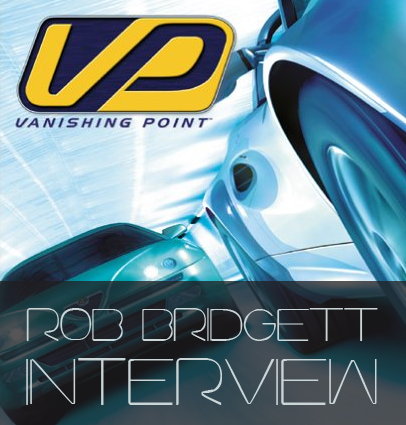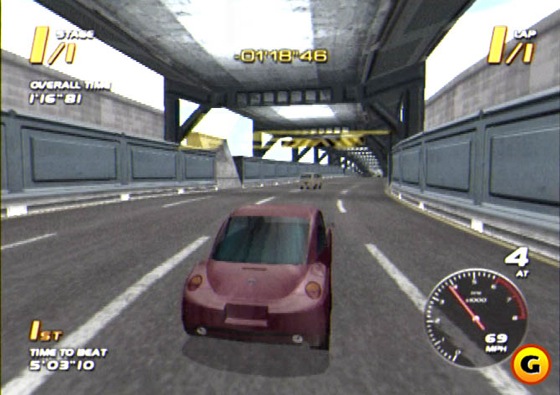
Here is a second exclusive interview with Rob Bridgett, talking about his first gig: Vanishing Point, a racing car game developed by Clockwork Games and published by Acclaim.
Designing Sound: Vanishing Point was tour first gig.. How you get involved with it?
Rob Bridgett: My first experience of working on sound design for a video game was when I was working at Matinee in Reading in June of 2000. They had a client called Clockwork Games out of Nottingham and had got the contract to supply music and sound effects for a racing title on the Dreamcast called ‘Vanishing Point’. I was originally brought on board at Matinee with my sound design background to work with Clockwork games on the sound design for this game, and I was pretty excited to get started. I’ve not written about this work before so I’m happy to recall working on that game!
DS: How was the working process on that title considering you were not an in-house member of their development team?
RB: I recall having a list of required sound effects for the game, through which I worked the best I could without even seeing the game running. These effects were then placed on their ftp server fro them to integrate, and the idea was that I could iterate once they had put them into the game and triggered them. I recall going through a few rounds of feedback like this before we eventually got them down to Reading for a couple of days to work directly with me on the sounds. All the vehicle engine sounds were being done elsewhere thankfully although I did supply lots of short loops for different road surfaces, such as gravel, which I recorded by spinning a tire round on some gravel outside of Matinee. I did have lots of time to concentrate on the environmental positional ambience effects such as wind farms and passing trains and planes, as well as designing all the sounds for the interface and HUD.
When the clients arrived, I believe there were the producer and the lead designer; we sat down in one of Matinee’s studios and set to work on the front end audio. They had brought with them a console and a development copy of the game so we could at least see some of the objects in the game for which we wanted sound effects and get a better idea of how they were conveyed in the game. The majority of the front end was designed using a Roland JP-8000, which was a lot of fun to work with and gave the front-end a cohesive sound design. We already knew the music track that would be playing over the front-end, so it was easy to design sounds that matched the tonality of the background music track. After a couple of days of going through all the sounds on their list together, we had pretty much nailed everything they wanted and everything that I’d done ended up in the final game.
DS: What were some of the important lessons learned from this working arrangement? It is kind of like being a freelance audio provider in a way, but working for a company…
RB: The thing that was most important to me about this whole first game audio gig was the opportunity to work directly with clients, and to understand through that, the nature of the iterative process. The first thing that struck me was that until I had actually seen the game, there was no way that I could create sound effects that I knew would work for the particular requirement. I could take a best guess and mix together some library sounds or record some new sounds to suit the name of the file on the list, but it was like working blind. To add to this, feedback that was provided via email fell even shorter in terms of honing the sounds to fit the requirements. Working directly with the clients, sitting down in front of the actual game, was the best option back then in 2000. Now one would expect to be able to work directly in the game engine with the client and change and preview sounds on the fly in order to actually preview them in game. Over the years I’ve seen many contractors that are expected to work on sound effects from a ‘list’ and receive descriptive feedback via email.
One of the main concerns I had when I was asked by our executive producer to bring in a Hollywood sound designer was that it shouldn’t be a case of just sending a laundry list of sound effects, but that the whole process should be as real-time and iterative as possible. This eventually turned into the post-production sound design phase that we carried out, bringing in Randy Thom as our post-production sound designer. We had the game running right there in his sound design suite, he’d create the sound effects, I’d build the content right there and then and we’d hear how it sounded in the game. We’d be able then to tweak implementation or go back to the sound offline and create something more desirable.

DS: Did you have propietary software to work with audio there? How was the sound engine of the game?
RB: There was no software for this, not that I got my hands on anyway, for me to integrate the sounds into the game. This all happened back in Nottingham. I seem to recall that the lead coder would hook up the sounds in the game, and that they would review them afterwards in subsequent builds. All of the multitrack mixing done at my end was with (then Sonic Foundry’s, now Sony’s) Vegas, I found it very intuitive and fast to work with, especially compared to Logic, which everyone else was using at the studio around that time. Everything I worked on made it into the final game, so I guess they must have liked what they heard.
DS: How the limitations of PlaySation and Dreamcast affect your work in that moment.
RB: At the time, and I guess this is often the case and still true now, it felt like ‘we had it good’ from a sound content and RAM/disc space perspective, there were samples that could be loaded into memory and good quality music that could be streamed off a disc. Looking back of course, it woud be difficult to use the approaches and amount of audio memory we are now used to. I do enjoy the challenge of imposing limits on the work done in sound, whether it is in terms of number of voices or even stylistic limits, but you have to have some kind of creative parameters to work within. I think that technical limitations create content of a certain style as a bi-product, which is an idea I find interesting from a creative standpoint. The limits were more evident in the very old days of the Commodore 64 for instance, and the styles used for music and sounds were completely driven by what could be done on the chip. Now we are all using ‘samples’ and working in a sample-based sound environment in games, things have become a lot more open in terms of sonic styles.
DS: How long it took you to create and develop all the sounds? What’s the more difficult part of the process?
RB: The whole process took around 2 months or so. In terms of actual sound design time I probably worked for ound 14 days total, I would also have been working on other projects around the same time at Matinee.The 2 months allowed for some iteration time as well as chatting with and meeting the clients and learning about their game.
DS: There are 32 different cars in the game.. Did you record all the engine sounds, skid noises, and impacts sounds from scratch? How was that process?
RB: I provided impacts and skids, as well as lots of various surface type loops that could augment the sounds of the engines. I didn’t do any of the engine sounds themselves, as the publisher, Acclaim, had those done elsewhere with a team that was able to go out and record the right car types. This was very much the right thing to do, engine recording, design and implementation is a very tricky process and having someone a lot closer to the game work on that made a lot of sense, it was also a huge releif for me not to have to do 32 engines for my first gig!

DS: What sort of gear did you employ for Foley and sound recording?
RB: As I recall, most of the sound collection I did was using a portable DAT recorder, I don’t recall the mic I used. I was really into Minidics at the time too so probably used that to record a lot of sounds, for example the sound of tires on different surfaces. I also made good use of the recording studio facilities at Matinee to get clean impact and material types recorded, for example I recall using one of those old electric bar heaters in one of the studios as a metallic element. A lot of it needed to be recorded from scratch as Matinee only had at the time a very small sound effects library. All these sounds would be premixed in Vegas and then exported into single .wav files that Clockwork Games could drop into the game.
DS: Finally… What did you learn of that work? How it helped in the evolution of your career?
RB: I’d like to talk a little more about working with clients, as this is something that every sound person does on a daily basis, even if they are in-house as an audio director. The game team is your ‘client’ in a sense, and I feel very strongly that a similar relationship applies as it would for a sound contractor. With any sound work that marries to a visual image, in a sense the image, and all the people who work on it and are responsible for it, are your client. There should be a relationship of mutual trust and respect that goes both ways. I always try to ‘try out’ suggestions made by my clients, even when my first instinct is that it is something horrendous that will never work in a million years, and I am often pleasantly surprised by the results, sometimes it is as horrible as predicted but as long as we can then both hear that it doesn’t work, the process becomes much easier.
One of the best, and only, books that I’ve found that talks directly about the whole client relationship is a book for graphic designers called ‘How to be a Graphic Designer Without Losing Your Soul’ by Adrian Shaughnessy. You can go through this entire book replacing the word ‘designer’ with ‘sound designer’ and pretty much have a tailor made book about working in the industry as a sound artist. There are such topics as what to do when a client rejects three weeks worth of work and refuses to pay the bill. It deals with commerce aspects such as starting your own freelance business as well as some wonderful creative process ideas and tips that are readily applicable to sound work. I find a lot of inspiration in books and ideas from other media, there is so little written about sound from these kinds of perspectives, you kind of have to go elsewhere to find common approaches.
Images: Vanishing Point at GameSpot